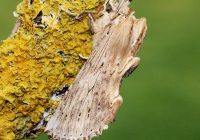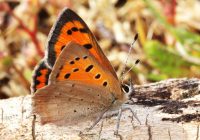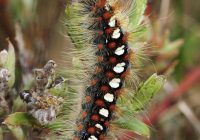Dr Phil Smith’s Wildlife Notes
May 2012
May is a great month for getting out and enjoying the wonderful variety of wildlife on the Sefton Coast. Wildflowers burst into bloom, butterflies suddenly appear in numbers and the richness of birdlife is enhanced by returning summer visitors. Migrant birds, held up by the adverse winds of April, came pouring through at the start of the month. A morning walk in the Ravenmeols woods on 2nd found Chiffchaffs, Willow Warblers and Blackcaps everywhere, while less usual songsters here included Sedge and Grasshopper Warblers. Orange Tip butterflies were attracted to the sheets of hybrid Bluebell and Pink Purslane which dominate the non-native ground flora in these woods. That afternoon, Seaforth Nature Reserve was similarly busy with migrants, with dozens of Wheatears, lots of White Wagtails and single Redstart and Whinchat. More remarkable, however, was the variety of terns, with Common, Arctic, Sandwich and Black all on view, while 160 Little Gulls flew up and down the freshwater pool delicately picking midges from the water’s surface.
The following day, Cabin Hill National Nature Reserve contributed more Wheatears and another Whinchat, while the small wood had within its carpet of hybrid Bluebells one classic Spanish Bluebell, relatively hard to find nowadays amongst all the hybrids. I also found time to dash up to Marshside Nature Reserve to see a Curlew Sandpiper and a Spotted Redshank, ending a productive day by photographing a striking Pale Prominent that a friend had found in his moth-trap.
On 6th, Freshfield Dune Heath Nature Reserve provided the best views I have ever had of a singing Lesser Whitethroat, while pond edges had both Slender and Common Groundhoppers, together with the little beetle Elaphrus cupreus that I found at Ainsdale in April. Nearby, at least 10 Small Coppers were enjoying the spring sunshine.
A freezing northerly wind and torrential showers retuned on 11th for the annual guided walk round Altcar Rifle Range to see the thousands of Green-winged Orchids – a vision in purple as usual but with more of the salmon pink and white varieties than I remember. A wandering Hedgehog and the first Small Heath butterfly of the year seemed oblivious to the cold.
A big turn-out for the Wildlife Trust’s 50th anniversary at Formby Golf Club on 19th was followed by walks around Freshfield Dune Heath and Ainsdale NNR. Cool, cloudy conditions restricted the range of wildlife on view but both groups were able to see the management needed to maintain open habitats and the specialised plants and animals for which these reserves are justly famous. For example, scrub control and turf-stripping on the heath has greatly increased populations of the regionally rare Bird’s-foot (Ornithopus perpusillus), a diminutive member of the pea family.
Later in the month I made several visits to the group of ponds in the Birkdale frontal dunes where Sefton’s Landscape Partnership Scheme organised restoration works in early March. It was hoped that the removal of choking vegetation and scrub would improve conditions for dragonflies and other wildlife. Sure enough, several kinds of dragonflies and damselflies performed well, especially Four-spotted Chasers newly emerged from their aquatic nymphal stage and therefore relatively easy to photograph. Also encouraging was a colony of 15 Bee Orchids on a dune slope recently cleared of invasive Sea Buckthorn.
Last May, I described the spectacular emergence of White Satin moths at Ainsdale Sandhills Local Nature Reserve. It looks as though this year’s populations are even larger and more widespread in the slacks south of the Discovery Centre. Over large areas the Creeping Willow was completely stripped of its leaves and the spectacularly colourful, hairy caterpillars were everywhere. While admiring them on 30th, I was surprised to see a Short-eared Owl flying over, normally a winter visitor. However, by far the best birds of the month were a Montagu’s Harrier at Martin Mere and the Ribble Estuary on 19-20th and a Woodchat Shrike near Lydiate on 30th.




